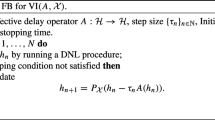Abstract
Augmented Infinitesimal Perturbation Analysis is used to determine asymptotically unbiased and strong consistent gradient estimates for use in the capacity planning of intree ATM networks. These gradients are used to determine the locally optimal minimum average network delay by applying a steepest descent algorithm with projection and an Armijo line search to solve the capacity assignment (CA) problem. The network capacities are governed by a linear cost constraint. It is assumed that input regulators (e.g., leaky bucket regulators) are used at the source of each virtual circuit. All virtual circuit external arrivals are modeled as independent Poisson processes. Regenerative simulation is used to determine gradient estimates.
Similar content being viewed by others
References
L. Armijo. 1966. Minimization of functions having Lipschitz continuous first-partial derivatives. Pacific J. Math. 16(1): 1–3.
C. A. Brooks. 1997. An augmented IPA algorithm for ATM networks. Preprint.
C. A. Brooks and P. Varaiya. 1995a. DETNA — Design and evaluation tool for network applications. Proc. of the Third INFORMS Telecommunications Conference, March.
C. A. Brooks and P. Varaiya. 1995b. Strong consistency of infinitesimal perturbation analysis for symmetric ATM intree networks. Proc. of the 33rd Annual Allerton Conference on Communication, Control, and Computing, October.
C. A. Brooks and P. Varaiya. 1995c. Using perturbation analysis to solve the capacity and flow assignment problem for general and ATM networks. Proc. of 3rd International Conference on Telecommunication Systems Modeling and Analysis, pp. 19–32, March.
C A. Brooks and P. Varaiya. 1997. A strong consistent gradient estimate for service distributions with atoms. To be submitted to Performance Evaluation, January.
C. A. Brooks, S. Wei, H. Li, and C. J. Walker. AND–ATM network design system. 1997. Proceedings of the Fifth Annual Symposium on Modeling, Analysis and Simulation of Computer and Telecommunication Systems (MASCOTS '97), January.
X.-R. Cao, W.-B. Gong, and Y. Wardi. 1995. Ill-conditioned performance functions of queueing systems. IEEE Trans. Automatic Control 40: 1074–1079.
C. G. Cassandras. 1993. Discrete Event Systems: Modeling and Performance Analysis. Aksen Associates Incorporated Publishers.
C. G. Cassandras, M. V. Abidi, and D. Towsley. 1990. Distributed routing with on-line marginal delay estimation. IEEE Trans. Comm. 38(3): 348–359, March.
C. G. Cassandras, J.-I. Lee, and Y.-C. Ho. 1990. Effecient parametric analysis of performance measures for communication networks. IEEE J. Sel. Areas Comm. 8(9): 1709–1722, December.
C. G. Cassandras and S. G. Strickland. 1988. Perturbation analytic methodologies for design and optimization of communication networks. IEEE J. Sel. Areas Comm. 6(1): 158–171, January.
C.-S. Chang and J. Cheng. 1995. Computable exponential bounds for intree networks with routing. IEEE INFOCOM, pp. 197–204, April.
C.-S. Chang, P. Heidelberger, S. Juneja, and P. Shahabuddin. 1994. Effective bandwidth and fast simulation of atm intree networks. Performance Evaluation 20: 45–66.
R. L. Cruz. 1991. A calculus for network delay — Part I: network elements in isolation. IEEE Transactions on Information Theory 37(1): 114–131, January.
R. L. Cruz. 1991. A calculus for network delay — Part II: network analysis. IEEE Transactions on Information Theory 37(1): 132–141, January.
L. Fratta, M. Gerla, and L. Kleinrock. 1973. The flow deviation method: An approach to store-and-forward communication network design. Networks 3: 97–133.
A. A. Gaivoronski, L. Y. Shi, and R. S. Sreenivas. 1992. Augmented infinitesimal perturbation analysis: An alternate explanation. Discrete Event Dynamic Sys.: Th. and Appl. (J. Discrete Event Dynamic Systems 2: 121–138.
B. Gavish and I. Neuman. 1989. A system for routing and capacity assignment in computer communciation networks. IEEE Trans. Comm. 37(4): 360–366, April.
M. Gerla and L. Kleinrock. 1977. On the topological design of distributed networks. IEEE Trans. Comm. 25(1): 48–60, January.
P. Glasserman. 1991. Gradient Estimation Via Perturbation Analysis. Kluwer Academic Publishers.
P. W. Glynn. Special issue. 1996. Discrete Event Dynamic Sys.: Th. and Appl. (J. Discrete Event Dynamic Systems), 6.
P. Heidelberger, X.-R. Cao, M. A. Zazanis, and R. Suri. 1988. Convergence properties of infinitesimal perturbation analysis estimates. Mgmt. Sci. 34(11): 1281–1302, November.
Y.-C. Ho and X.-R. Cao. 1991. Perturbation Analysis of Discrete Event Dynamic Systems. Kluwer Academic Publishers.
L. Kleinrock. 1964. Communication Nets: Stochastic Message Flow and Delay. McGraw-Hill Book Company.
L. Kleinrock. 1975. Queueing Systems: Volume 1. Wiley.
A. M. Law and W. D. Kelton. 1991. Simulation Modeling and Analysis. McGraw-Hill, Inc.
D. G. Luenberger. 1984. Linear and Nonlinear Programming. Addison-Welsey Publishing Company.
S.-M. Lun, F. Wu, N. Xiao, and P. Varaiya. To appear. NetPlan: An integrated network planning environment. State of the Art in Performance Modeling and Simulation, Volume 1: Computer and Communication Networks.
G. S. Shedler. 1993. Regenerative Stochastic Simulation. Academic Press.
R. Suri. 1989. Perturbation analysis: The state of the art and research issues explained via the GI/G/1 queue. Proc. IEEE, 77(1): 114–137, January.
J. S. Turner. 1986. New directions in communications (or which way to the information age?). IEEE Communications Magazine 24(10): 8–15, October.
Y. Wardi and K. Lee. 1991. Application of descent algorithms with Armijo stepsizes to simulation-based optimization of queueing networks. Proc. of the 30th Conference on Decision and Control, pp. 110–115.
Y. Wardi, M. W. McKinnon, and R. Schuckle. 1991. On perturbation analysis of queueing networks with finitely supported service time distributions. IEEE Trans. Automatic Control 36(7): 863–867, July.
N. Xiao, F. F. Wu, and S.-M. Lun. 1994. Dynamic bandwidth allocation using perturbation analysis. IEEE INFOCOM, pp. 383–389, June.
Author information
Authors and Affiliations
Rights and permissions
About this article
Cite this article
Brooks, C.A., Varaiya, P. Using Augmented Infinitesimal Perturbation Analysis for Capacity Planning in Intree ATM Networks. Discrete Event Dynamic Systems 7, 377–390 (1997). https://doi.org/10.1023/A:1008214527268
Issue Date:
DOI: https://doi.org/10.1023/A:1008214527268




